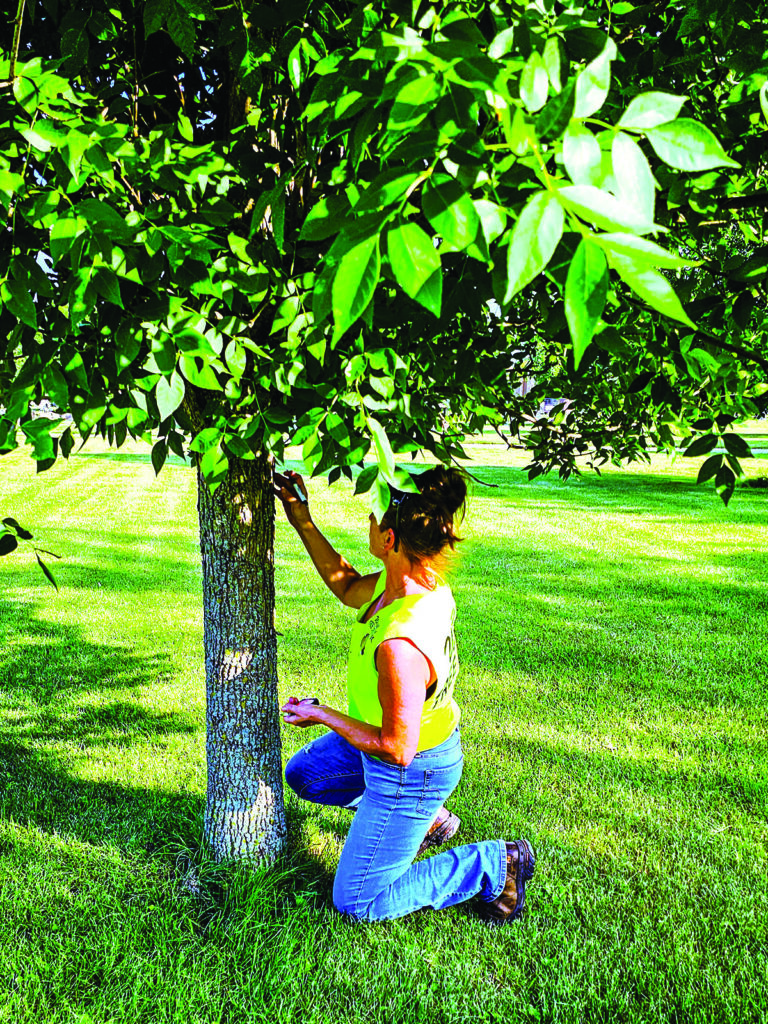From Extra-ordinary living magazine Fall 2023
Nancy Edmonds Hanson

Sherrie Moore inspects an ash tree for signs of emerald ash borer infestation.
Keeping trees healthy is arborist Sherrie Moore’s mission.
Sherrie Moore is keeping an eye on the treetops. She is concerned – not only about the nutritional needs, fungal diseases and native insects that have always threatened the treasured trees of this prairie land, but a new enemy that threatens to wipe out an entire species.
“The emerald ash borer is ten times the threat that we faced with Dutch elm disease,” warns the lean, deeply tanned owner of Walt’s Tree Service. “Unlike Dutch elm disease, the EAB will find every single ash tree in its path. If you don’t treat them, they will die.”
As a certified arborist – a specialist in the cultivation and care of trees and shrubs – the West Fargo woman has found herself on the front lines of a battle for Fargo-Moorhead’s trees. When larvae of the tiny, shiny green beetles was spotted near The Meadows in Moorhead this spring, she turned much of her attention to helping thwart the nonnative pest. “About 70% of our business is focused now on ash trees,” she explains. “It’s urgent! If we don’t get product into the trees, it’s not whether they will die. It’s just a question of when.”
Sherrie’s company is one of half a dozen or so engaged in the battle to keep ash trees green and the rest of the urban forest shady. Tree care has been part of her life since 1982, when her father, Walt Erdmann, started providing tree care part-time while working as a machinist at Steiger Tractor. He had learned the basics by working with his brother in Aberdeen, South Dakota, in the 1970s.
Sherrie and her brother Troy were helping Dad load branches when they were 10 and 12. “At 15, I was running the stump grinder and learning chainsaws,” Sherrie recalls. “As we got older, we recruited friends and in-laws … almost the whole extended family.”
By the time she graduated from West Fargo High School in 1990, she had other ideas – indoors. She studied interior design at Lowthian College (which evolved into the Minneapolis Art Institute), then worked full-time in her field at Ethan Allen. Meanwhile, though, she continued helping her father in her free time.
“By the spring of 2006, I realized I couldn’t do both,” she says. “It was one or the other. Dad retired and went into the business full-time, and so did I.” She became the sole owner of the business in 2020. Walt continues to work with her, along with her son TeJay and Jeanlee Va. Her nephew Travis helps with trimming and removal under his own brand, Slim’s Tree Care.
With 20 years of experience as a certified arborist, Sherrie has handled every side of the tree business, from behind-the-scenes management to cutting down trees. “I drove dump trucks when I was pregnant,” she laughs. “I ran the stump grinder so long that I wore out my hands.”
And now she operates the Q-connect injection machine that’s the key to saving ash trees. Outfitted from head to toe in a Tychem hazmat suit, she sinks needles around the diameter of her leafy “patients,” then connects the tubing to the high-pressure injector. The chemical is taken up through the tree’s phloem (the arbor equivalent of arteries and veins), protecting it from incursions by EAB larvae.
Mature beetles munch on ash trees’ leaves, but that’s not the worst of it. The females lay eggs twice a year. After hatching, larvae feed on the nutrient-rich tissue, tunneling just below tree’s bark and forming S-shaped channels. As they suck its moisture and sap, the tree can’t move food and water from its roots to its leaves. Eventually it dies.
The fight against the emerald ash borer is the top priority of local foresters today, with ash trees making up an estimated 25% of trees on the community’s public lands, perhaps equal to the share on private property. Ironically, many of those trees were planted in the 1980s and 1990s … to replace elm trees decimated by the earlier epidemic.
But the borers are far from the only headache tree doctors treat. Sherrie points to iron chlorosis, for example: “Our iron-poor clay soils are really rough, especially for larger maple and birch trees.” Other diseases and pests are everyday issues, like coddle moths and apple maggots. The docs treat broken limbs and trunks twisted by overly vigorous winds. Other challenges are man-made, from bark damage at the base caused by too-aggressive weed whackers to the overall issue of climate change and rising temperatures.
“Trees are vital to our way of life,” the arborist emphasizes. “They provide wildlife with food and living quarters. They provide cooling shade. They retain moisture and hold the soil.
“The biggest thing of all is how they clean the air. They reduce pollution and absorb greenhouse gases. We need to pay more attention to their needs,” she says. “With good, regular care, you can rescue a tree that’s in decline and, over time, get it back to healthy, vigorous growth.”

